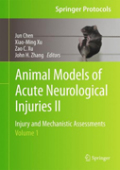
Animal models of acute neurological injuries II v. 1 Injury and mechanistic assessments
Chen, Jun
Xu, Xiao-Ming
Xu, Zao C.
Zhang, John H.
The successful previous volume on this topic provided a detailed benchwork manual for the most commonly used animal models of acute neurological injuries including cerebral ischemia, hemorrhage, vasospasm, and traumatic brain and spinal cord injuries. Animal Models of Acute Neurological Injuries II: Injury and Mechanistic Assessments aims to collect chapters on assessing these disorders from cells and molecules to behavior and imaging. These comprehensive assessments are the key for understanding disease mechanisms as well as developing novel therapeutic strategies to ameliorate or even prevent damages to the nervous system. Volume 1 examines general assessments in morphology, physiology, biochemistry and molecular biology, neurobehavior, and neuroimaging, as well asextensive sections on subarachnoid hemorrhage, cerebral vasospasm, and intracerebral hemorrhage. Designed to provide both expert guidance and step-by-stepprocedures, chapters serve to increase understanding in what, why, when, where, and how a particular assessment is used. . Accessible and essential, Animal Models of Acute Neurological Injuries II: Injury and Mechanistic Assessmentswill be useful for trainees or beginners in their assessments of acute neurological injuries, for experienced scientists from other research fields who areinterested in either switching fields or exploring new opportunities, and forestablished scientists within the field who wish to employ new assessments. Presents the material in a disease/disorder oriented manner for convenientreference. Offers both recommended, established techniques and alternative methods that have their own special utility. Features key tips and implementation advice to ensure successful results. INDICE: Histopathological Assessments of Animal Models of Cerebral Ischemia. Assessment of Cell Death: Apoptosis, Necrosis, or In Between. The Stereology and 3D Volume Analyses in Nervous Tissue. Assessments of Reactive Astrogliosis Following CNS Injuries. Physiological Assessment in Stroke Research. EEG, Evoked Potential (EP), and Extracellular Single Unit Recordings In Vivo. Intracellular Recording In Vivo and Patch-Clamp Recording on Brain Slices. Electrophysiological Evaluation of Synaptic Plasticity in Injured CNS. Characterizationof RNA. MicroRNA Expression Profiling of Rat Blood and Brain Tissues: TaqMan Real-Time PCR MicroRNA Assays. Protein Analysis. Application of Zymographic Methods to Study Matrix Enzymes Following Traumatic Brain Injury. Rodent Behavioral Assessment in the Home Cage Using the SmartCageTM System. Assessments of Cognitive Function Following Traumatic Brain Injury. Assessment of Cognitive and Sensorimotor Deficits. Emotional and Anxiety Assessments in CNS Disorders. Neuroimaging Assessment of Traumatic Brain Injury. Imaging of Myelin by Coherent Anti-Stokes Raman Scattering Microscopy. Grading Scales for Subarachnoid Hemorrhage. Acute Physiologic and Morphologic Assessment Following Subarachnoid Hemorrhage. Aneurysmal Subarachnoid Hemorrhage Grading in Animal Models. Physiological Assessments of Subarachnoid Hemorrhage. Spreading Depolarization. Assessment of Neurovascular Coupling. Assessment of Global Ischemia. Assessment ofMicrothromboembolism after Subarachnoid Hemorrhage. Intracranial Pressure Assessments. Assessment of Blood-Brain Barrier Breakdown. Electrophysiology and Morris Water Maze to Assess Hippocampal Function after Experimental Subarachnoid Hemorrhage. Biochemical and Molecular Biological Assessments of SubarachnoidHemorrhage. Neurobehavioral Assessments of Subarachnoid Hemorrhage. Neuroimaging Assessment of Subarachnoid Hemorrhage. Introduction to Problems of Post-Subarachnoid Hemorrhage Delayed Cerebral Vasospasm. Morphological Assessments ofCerebral Vasospasm. Vasospasm: Measurement of Diameter, Perimeter and Wall Thickness. Light Microscopic Assessment. Electron Microscopic Assessment. Morphological Assessment of Microcirculation. Electrophysiological Assessment of Cerebral Vasospasm. Cranial Window Assessments in Experimental aSAH in Mice. Laser Speckle Contrast Analysis (LASCA) Imaging. Ion Channel Assessment. Biochemical Assessments of Cerebral Vasospasm: Measurement of cGMP, PKC, and PTK in Cerebral Arteries. Assessment of Intracellular Calcium in Cerebral Artery Myocytes. Neurobehavioral Assessments of Cerebral Vasospasm. Neuroimaging Assessment of Cerebral Vasospasm. Morphological Assessment of Intracerebral Hemorrhage. Immunological Response to Experimental Intracerebral Hemorrhage: Morphological Assessments. Intracranial Pressure Assessment. Hemoglobin Measurements. Biochemical and Molecular Biological Assessments of Intracerebral Hemo
- ISBN: 978-1-61779-575-6
- Editorial: Humana Press
- Encuadernacion: Cartoné
- Páginas: 847
- Fecha Publicación: 30/04/2012
- Nº Volúmenes: 1
- Idioma: Inglés
